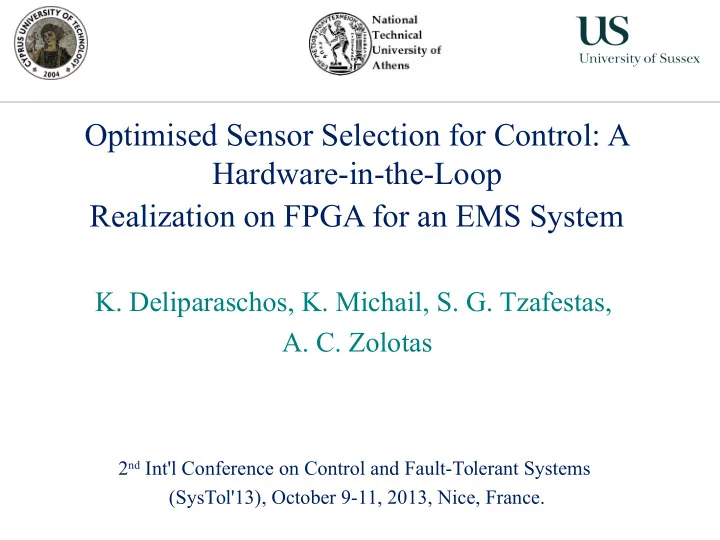

Optimised Sensor Selection for Control: A Hardware-in-the-Loop Realization on FPGA for an EMS System K. Deliparaschos, K. Michail, S. G. Tzafestas, A. C. Zolotas 2 nd Int'l Conference on Control and Fault-Tolerant Systems (SysTol'13), October 9-11, 2013, Nice, France.
Systol’13, Nice (FR) CONTENTS Introduction and the proposed framework Maglev suspension (case study) FPGA-In-the-Loop with Kalman estimator Results Conclusions
Systol’13, Nice (FR) A Typical Control System Disturbances Uncertainties System Could be nonlinear; Faults Faults Stable? Which is the best sensor/actuator set for control (and fault tolerance)?
Why number of sensors ... Systol’13, Nice (FR) Within the control properties: Sensor (Actuator) fault tolerance Minimize complexity Reduce cost Provide balance of robustness/optimised performance Sensor optimisation framework adopted here: K. Michail, A. Zolotas, and R. M. Goodall, J. F. Whidborne. Optimised configuration of sensors for fault tolerant control of an electromagnetic suspension system. International Journal of Systems Science, 43(10):1785–1804, 2012 using Hardware-In-The-Loop (HIL) concept.
Systol’13, Nice (FR) Framework flowchart Overall control constraint violation function If Ω=0 then performance requirements are satisfied. If Ω≠0 then there is some violation of control constraints. Controller selection criteria Used for the final selection of controller Sensor fault accommodation ratio (Future work)
Systol’13, Nice (FR) The HIL Concept Hardware-based Communication Software-based (FPGA) Channel Model of the plant Controller implementation Model of the plant will be Controller is realized embedded in software on an FPGA board (Simulink/MATLAB) FPGA-In-The-Loop (FIL)
Systol’13, Nice (FR) Sections Introduction and the proposed framework Maglev suspension (case study) FPGA-In-the-Loop with Kalman estimator Results Conclusions
Systol’13, Nice (FR) The test case: Maglev System Controller Track K Flux circulation Pole Airgap Electromagnet Driving Signal Current F Vert. Accleration Vert. Velocity Power Amplifier Mg EMS serves two purposes: Suspended mass (m) Support the vehicle and passengers Ensure proper ride quality
Input disturbances and Systol’13, Nice (FR) performance requirements Stochastic Deterministic Performance requirements > Deterministic and Stochastic control performance using minimum number of sensors.
Systol’13, Nice (FR) Sections Introduction and the proposed framework Maglev suspension (case study) FPGA-In-the-Loop with Kalman estimator Results Conclusions
FIL for the Systol’13, Nice (FR) MAGLEV suspension 1 Sensor 2 selection High Level Software 3 FIL realization
FPGA design /implement Systol’13, Nice (FR) Xilinx Spartan-6 SP605 development board (XC6SLX45TFGG484-3C device) in 484-pin fine Ball Grid Array package SP605 board features an ethernet physical interface transceiver chip KBE + peripheral cores synthesized via Xilinx Synthesis Tool
FPGA design /implement Systol’13, Nice (FR) Required wordlength Inequality for combined range + resolution > KBE achieves system clock > operating freq. of 39.544ns
HIL design / implementation Systol’13, Nice (FR) flow diagram Discretization MATLAB Quantization Implementation on FPGA FPGA
Systol’13, Nice (FR) Sections Introduction and the proposed framework Maglev suspension (case study) FPGA-In-the-Loop with Kalman estimator Results Conclusions
Optimised sensor Systol’13, Nice (FR) selection for maglev case LQR Test Similar response
Optimised sensor Systol’13, Nice (FR) selection on maglev case LQR Test Similar response
Airgap deflection Systol’13, Nice (FR) (deterministic) continuous-time KE vs. FIL-implemented KEC
State estimation Systol’13, Nice (FR) performance (deterministic) current velocity Airgap
Systol’13, Nice (FR) Conclusions & Discussion Practical investigation of optimised sensor selection for control on FPGA Attempt to minimizing complexity Shows potential for industrial applications
Optimised Sensor Selection for Control: A Hardware-in-the-Loop Realization on FPGA for an EMS System K. Deliparaschos, K. Michail, S. G. Tzafestas, A. C. Zolotas A. Zolotas acknowledges University of Sussex travel grant support
Recommend
More recommend